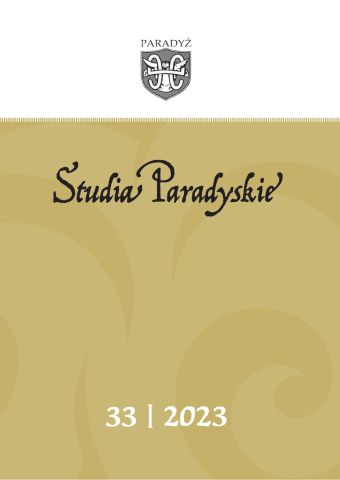
ISSN: 0860-8539
eISSN: 2956-4204
OAI
DOI: 10.18276/sp.2023.33-01




Issue archive /
33/2023
Il libro di Paolo e Francesca: amori veri e falsi nella Divina Commedia
(The Book between Paolo and Francesca: The True and False Love in Divina Commedia)
| Authors: |
Marino
Balducci

Uniwersytet Szczeciński |
| Keywords: | adultery Amoris laetitia Dante Divine Comedy Francesca da Rimini homosexuality Lancelot |
| Data publikacji całości: | 2023-12 |
| Page range: | 16 (5-20) |
| Downloads ?: | 102 |
Abstract
For Dante and Christianity it is certainly not sex, nor adultery per se or promiscuity, which leads us to mortal sin capable of killing our soul, closing us in hell: and in this sense we can think of fundamental emblems, like the woman of Samaria, the adulteress and the Magdalene of the Gospel. A sincere sexuality radiated with love, True Love, always leads gradually to the glory of heaven: this is the message hidden in the symbols of the Divine Comedy. The cause of inner death and anguish that makes us deeply unhappy (and therefore ‘imprisoned’... – captivi diaboli) is instead the superficiality of our experience of love, rancor and hypocrisy together with the desire to overwhelm others, as in the famous case of Paolo and Francesca. The latter is analyzed in this study with cross-references to the love legends of Lancelot and Tristan, as well as to the poetic love between Arnaut Daniel and Bertrand de Born. The theme of homoeroticism is therefore addressed with regard to Brunetto Latini in hell, however considering that Dante’s vision symbolically shows us that sodomy, as an external act of the body induced by a spontaneous and immediate impulse of the senses, is not in itself a cause of damnation. As can be observed among the various spirits of carnal lovers in purgatory and paradise, the death of the soul seems for the poet to be connected only to an inner risk, an ambiguous limit which is narcissism and selfish isolation within our intellect or political practice. In his tolerant erotic morality, Dante seems to be influenced by the Joachimite movements of the Free Spirit.
Download file
Article file
Bibliography
| 1. | Barillari S.M., La «Storia vera» di Luciano e i percorsi carsici della tradizione, [in:] In cammino verso la casa della sapienza, a c. di P.A. Rossi, I. Li Vigni, Monza 2016. |
| 2. | Bromwich R., Trioedd Ynys Prydein: The Triads of the Island of Britain, Cardiff (UK) 1978. |
| 3. | Brooker CH.N.L., Il matrimonio nel Medioevo, Bologna 1992. |
| 4. | Francesco da Buti, Commento sopra la Divina Commedia di Dante Allighieri, a c. di C. Giannini, Pisa 1858. |
| 5. | Chocheyras J., Tristan et Iseut. Genèse d’un mythe littéraire, Paris 1996. |
| 6. | Coletti F., Cunizza da Romano, [in:] Enciclopedia dantesca, https://www.treccani.it/enciclopedia/cunizzada-mano_%28Enciclopedia-Dantesca%29/. |
| 7. | Delcorno Branca D., Tristano e Lancillotto in Italia. Studi di letteratura arturiana, Ravenna–Longo 1998. |
| 8. | Duby G., Il cavaliere, la donna e il prete, Bari–Roma 1982. |
| 9. | Ferzoco G.P., Il murale di Massa Marittima, Firenze 2004. |
| 10. | Francesco S.P., Esortazione apostolica postsinodale ‘Amoris laetitia’, 301; 295 296, 297, 299, http://w2.vatican.va/content/francesco/it/apost_exhortations/documents/papafrancesco_esortazioneap_20160319_amoris-laetitia.html. |
| 11. | Frenschkowski M., Maria Maddalena, [in:] Biographisch-Bibliographischen Kirchenlexikons, vol. 5, Herzberg 1993, pp. 815–819. |
| 12. | Gaudemet J., Il matrimonio in Occidente, Torino 1987. |
| 13. | Goodrich N.L., Guinevere, New York 1992. |
| 14. | Guarnieri R., Il movimento del Libero Spirito, “Archivio italiano per la storia della pietà” iv (1965), pp. 400–435. |
| 15. | Hopkins A., The Book of Guinevere: Legendary Queen of Camelot, New York 1998. |
| 16. | Ingeborg W., Carlo Martello d’Angiò, re d’Ungheria, [in:] Dizionario biografico degli italiani, vol. 20, Roma 1977. |
| 17. | Masciandaro F., Annotazioni sull’immagine del punto nella «Divina Commedia», [in:] La conoscenza viva. |
| 18. | Letture fenomenologiche da Dante a Machiavelli, Ravenna 1998, pp. 40–43. |
| 19. | Noakes S., The Double Misreading of Paolo and Francesca, “Philological Quarterly” 62 (1983) 2, pp. 221–239. |
| 20. | Onorati A., Dante e l’omosessualità. L’amore oltre le fronde, Roma 2009. |
| 21. | Webster K.G.T., Guinevere: A Study of Her Abductions, Milton 1951. |
| 22. | Punzi A., Tristano. Storia di un mito, Roma 2005. |
| 23. | Saxer V., Maria Maddalena, “Biblioteca Sanctorum” 8 (1966), pp. 1078–1104. |
| 24. | Silvestre J.B., Universal Palaeography, vol. 1, London 1849. |
| 25. | Swenson K., Mary Magdalene, https://www.bibleodyssey.org/en/people/main-articles/mary-ofmagdala. |
| 26. | Toschi P., Le origini del teatro italiano [1955], Torino 1976. |
| 27. | I trovatori, a c. di C. Di Girolamo, Torino 1993. |
| 28. | Vasina A., Malatesta, Paolo, [in:] Enciclopedia dantesca, https://www.treccani.it/enciclopedia/paolomalatesta_%28Enciclopedia-Dantesca%29/. |
| 29. | Viscardi A., Arnaldo Daniello, [in:] Enciclopedia dantesca, http://www.treccani.it/enciclopedia/arnaldodaniello_%28Enciclopedia-Dantesca%29/. |
| 30. | Viscardi A., Bertram dal Bornio, [in:] Enciclopedia dantesca, http://www.treccani.it/enciclopedia/bertramdal-bornio_%28Enciclopedia-Dantesca%29/. |
| 31. | Zatzikhoven U., Lanzelet, tradotto in inglese da T. Kerth, con note aggiuntive di K.G.T. Webster e R.S. Loomis, New York 2005. |
| 32. | M.A. Balducci, Il libro di Paolo e Francesca: amori veri e falsi nella Divina Commedia, Studia Paradyskie 33 (2023), 5–20, DOI: 10.18276/sp.2023.33-01. |